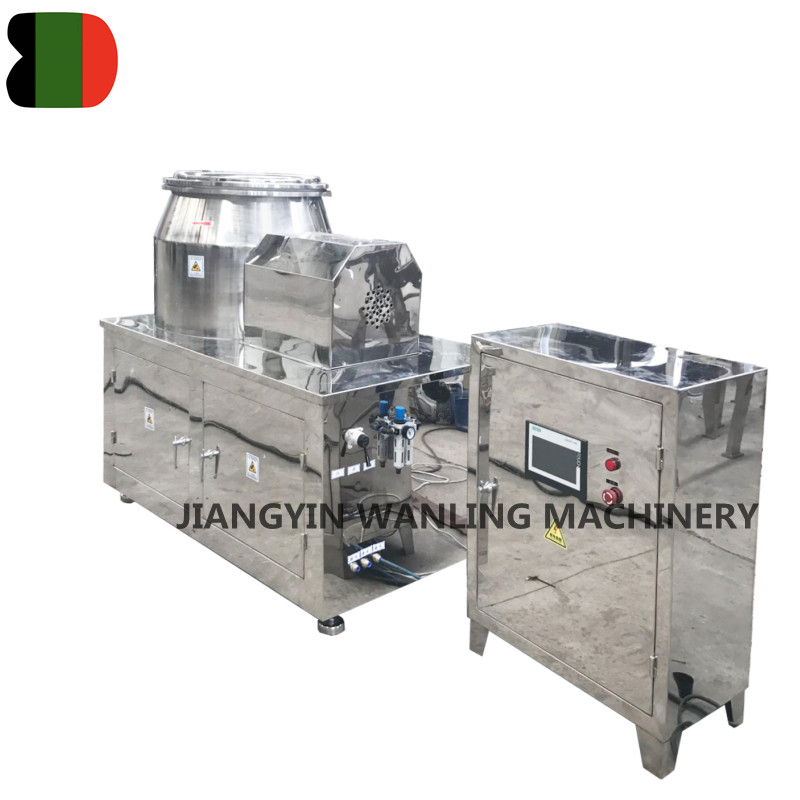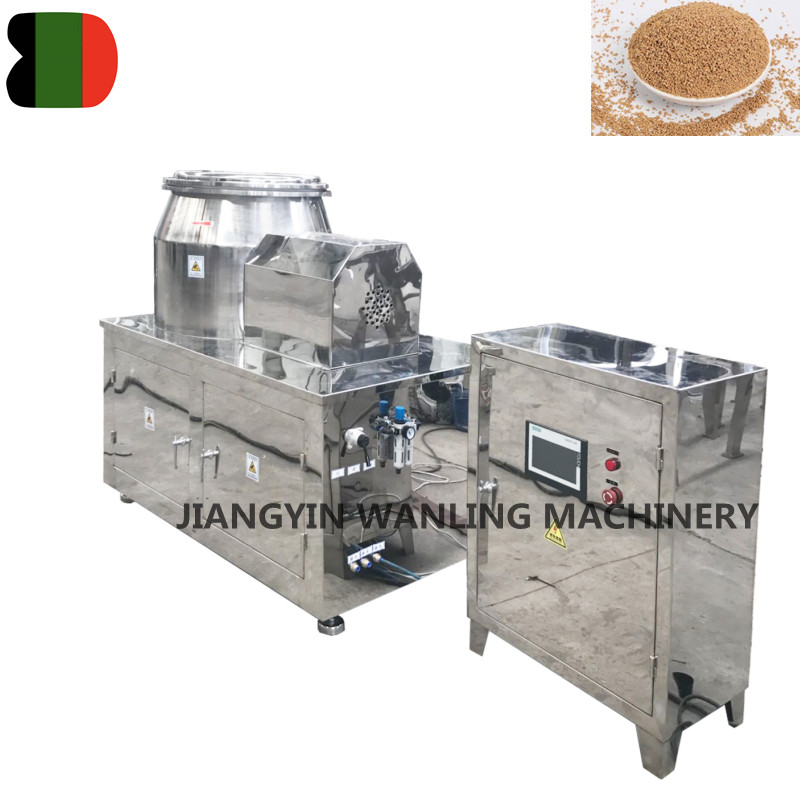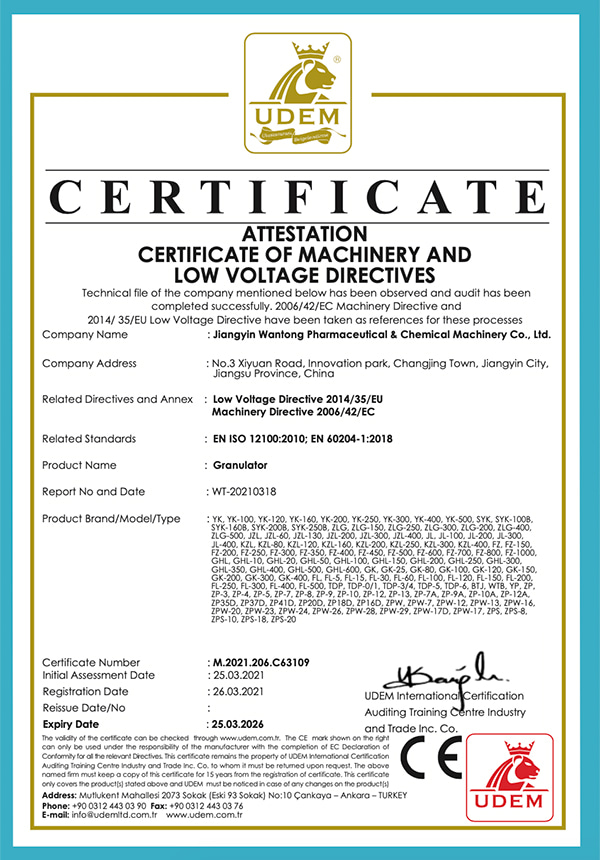High Shear Mixer Granulator Manufacturer
-


WHL High Shear Rapid Mixer Granulator
Effortless One-Step Granulation: The WHL series eliminates the need for separate blending and granulating equipment. Simply add your dry pow... -

WHL High Shear Pharmaceutical Powder Mixing Granulator Machine
WHL high shear pharmaceutical powder mixing granulator machine use a combination of impellers and choppers to create a forceful mixing actio... -

WHL High Speed Rapid Mixing Granulator
The WHL high speed rapid mixing granulator is a high-speed mixer granulator designed for efficient and rapid processing of raw materials. It... -


WHL high shear rapid mixer granulating granulator machine
The rapid mixer granulator machine mainly consists of blending system, cutting system, frame, mixing barrel, electric controlling box etc. B...
The rapid mixer granulator adopts a horizontal cylindrical structure with a reasonable structure. Fluidized granulation, forming spherical particles with good fluidity. A rapid mixer granulator mixes powder materials and adhesives in cylindrical or conical containers, thoroughly mixing them into wet soft materials using a bottom mixing paddle, and then cutting them into uniform wet particles using a side mounted high-speed grinding paddle.

About Us
Honor
-
 Honor
Honor -
 CE
CE
News
-
Industry News 2025-10-22
1. What a Horizontal Ribbon Mixer Is and Where It’s Used A horizontal ribbon mixer is an industrial ...
View More -
Industry News 2025-10-16
A tray dryer is a batch drying equipment widely used in the pharmaceutical, food, and chemical indus...
View More -
How does a double cone blender compare to ribbon blenders or V-blenders for industrial applications?Industry News 2025-10-09
A double cone blender has distinct advantages and limitations when compared to ribbon blenders and V...
View More -
Industry News 2025-10-01
Electric-Powered Tray Dryers Advantages: Precise and Stable Temperature ControlElectric-powered tr...
View More
Industry Knowledge Expansion
How do rapid mixer granulators handle different types of materials?
Rapid mixer granulators (RMGs) are designed to handle a wide variety of materials, making them versatile and essential equipment in industries such as pharmaceuticals, food processing, and chemicals. Here are the key ways in which RMGs manage different types of materials:
Variable Speed and Power Settings
Adjustable Impellers and Choppers: RMGs are equipped with variable speed settings for both impellers and choppers, allowing precise control over the mixing and granulation process. This flexibility ensures optimal processing for materials with different properties, such as density, particle size, and moisture content.
Power Adaptation: The power of the impellers and choppers can be adjusted to suit the material being processed. For example, higher power may be required for denser or more cohesive materials to achieve the desired granulation.
Customized Bowl Design
Bowl Geometry: The design and geometry of the mixing bowl can be customized to accommodate various material characteristics. For instance, bowls with specific shapes can promote better mixing and reduce dead zones where materials might accumulate.
Material of Construction: The construction material of the bowl can be selected based on the chemical properties of the materials being processed to prevent reactions or contamination.
Advanced Control Systems
Recipe Management: Advanced RMGs come with sophisticated control systems that allow for recipe management. Operators can program specific parameters tailored to different materials, ensuring consistent and repeatable processing.
Real-Time Monitoring: Sensors and control systems provide real-time data on parameters such as torque, temperature, and moisture content, enabling adjustments on-the-fly to handle different materials effectively.
Adaptability to Wet and Dry Granulation
Wet Granulation: RMGs can handle wet granulation processes by adding liquid binders to powders, which are then mixed and granulated simultaneously. The equipment is designed to manage the viscosity and flow characteristics of the wet mass efficiently.
Dry Granulation: For dry granulation, RMGs can process powders without the need for liquid binders, using high shear forces to compact and granulate the material.
Scalability and Batch Sizes
Small to Large Batches: RMGs are capable of processing different batch sizes, from small-scale laboratory formulations to large-scale industrial production. This scalability allows for testing and optimization of material handling before full-scale production.
Uniformity Across Batches: By maintaining consistent processing parameters, RMGs ensure uniformity in granule size and quality across different batches, regardless of material variations.
Optimized Impeller and Chopper Design
Impeller Configuration: The design and configuration of the impellers are critical for handling different materials. Impellers can be designed to provide the necessary shear and compression forces for effective granulation.
Chopper Integration: Choppers help in breaking down agglomerates and ensuring uniform granule size. The position and speed of choppers can be adjusted based on the material characteristics to achieve the desired granulation outcome.
Cleaning and Maintenance
Ease of Cleaning: RMGs are designed for easy disassembly and cleaning, which is crucial when switching between different materials to prevent cross-contamination.
Material-Specific Cleaning Protocols: Cleaning protocols can be tailored to the specific properties of the materials being processed, ensuring thorough removal of residues and maintaining hygiene standards.
Rapid mixer granulators are highly versatile machines that can handle a wide range of materials by adjusting various operational parameters, utilizing advanced control systems, and incorporating specific design features. This adaptability makes them invaluable in industries requiring precise and efficient granulation processes for diverse material types.
How does the Rapid Mix Granulator prevent cross contamination between different materials?
Rapid Mixer Granulators (RMGs) employ several design features and operational protocols to prevent cross-contamination between different materials. Here are the key measures:
Easy Disassembly and Cleaning
Modular Components: RMGs are designed with components that can be easily disassembled. This facilitates thorough cleaning of parts that come into contact with materials.
Smooth Surfaces: The internal surfaces of the mixing bowl and other contact parts are often polished and smooth to prevent material adherence and make cleaning more effective.
Material of Construction
Non-reactive Materials: Parts in contact with the product are usually made from non-reactive and corrosion-resistant materials like stainless steel, which are easy to clean and do not retain residues.
Cleaning Protocols
Cleaning-In-Place (CIP) Systems
Automated Cleaning: Many RMGs are equipped with Cleaning-In-Place (CIP) systems that automate the cleaning process. CIP systems ensure thorough and consistent cleaning, reducing the risk of cross-contamination.
Detailed Cleaning Procedures
Standard Operating Procedures (SOPs): Detailed SOPs for manual cleaning ensure that all parts of the RMG are cleaned according to industry standards, minimizing the risk of residual material.
Operational Protocols
Batch Documentation and Segregation
Batch Records: Maintaining detailed batch records helps in tracking the materials processed and ensures that cleaning is conducted appropriately between batches.
Material Segregation: Implementing strict material segregation protocols during processing and cleaning helps in avoiding cross-contact.
Regular Maintenance and Inspections
Scheduled Maintenance: Regular maintenance schedules ensure that all parts are inspected and cleaned regularly to prevent build-up of materials.
Visual Inspections: Routine visual inspections before and after cleaning processes help in identifying and removing any remaining residues.
Advanced Control Systems
Sensor Integration: Advanced control systems equipped with sensors can monitor cleanliness levels in real-time, ensuring that any contamination is detected and addressed immediately.
Alerts and Alarms: Automated alerts and alarms can notify operators if any part of the equipment is not cleaned properly, prompting immediate action to prevent cross-contamination.
Rapid Mixer Granulators incorporate a combination of design features, stringent cleaning protocols, operational procedures, and advanced control systems to prevent cross-contamination between different materials. These measures ensure that each batch is processed in a clean environment, maintaining product integrity and safety.



 Español
Español
